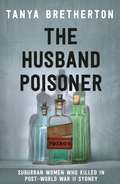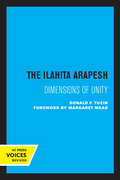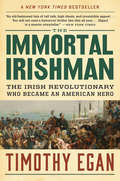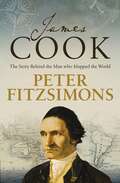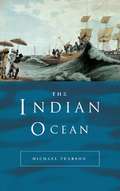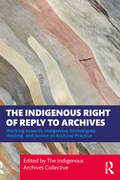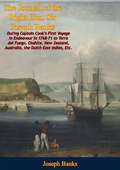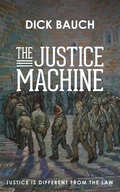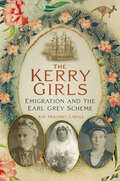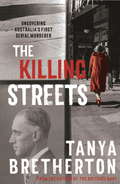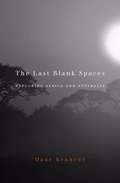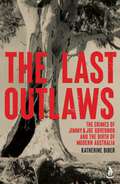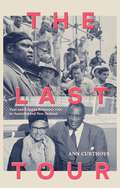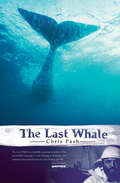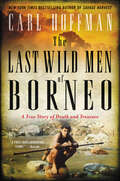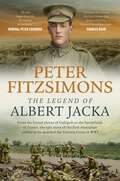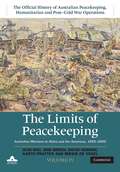- Table View
- List View
The Husband Poisoner: Suburban women who killed in post-World War II Sydney
by Tanya BrethertonShocking real-life stories of murderous women who used rat poison to rid themselves of husbands and other inconvenient family members. For readers of compelling history and true crime, from critically acclaimed, award-winning author Tanya Bretherton.After World War II, Sydney experienced a crime wave that was chillingly calculated. Discontent mixed with despair, greed with callous disregard. Women who had lost their wartime freedoms headed back into the kitchen with sinister intent and the household poison thallium, normally used to kill rats, was repurposed to kill husbands and other inconvenient family members. Yvonne Fletcher disposed of two husbands. Caroline Grills cheerfully poisoned her stepmother, a family friend, her brother and his wife. Unlike arsenic or cyanide, thallium is colourless, odourless and tasteless; victims were misdiagnosed as insane malingerers or ill due to other reasons. And once one death was attributed to natural causes, it was all too easy for an aggrieved woman to kill again.This is the story of a series of murders that struck at the very heart of domestic life. It's the tale of women who looked for deadly solutions to what they saw as impossible situations. The Husband Poisoner documents the reasons behind the choices these women made - and their terrible outcomes.
The Ilahita Arapesh: Dimensions of Unity
by Donald F. TuzinThis title is part of UC Press's Voices Revived program, which commemorates University of California Press’s mission to seek out and cultivate the brightest minds and give them voice, reach, and impact. Drawing on a backlist dating to 1893, Voices Revived makes high-quality, peer-reviewed scholarship accessible once again using print-on-demand technology. This title was originally published in 1976.
The Immortal Irishman: The Irish Revolutionary Who Became an American Hero
by Timothy Egan<P>From the National Book Award-winning and best-selling author Timothy Egan comes the epic story of one of the most fascinating and colorful Irishman in nineteenth-century America. <P>The Irish-American story, with all its twists and triumphs, is told through the improbable life of one man. A dashing young orator during the Great Famine of the 1840s, in which a million of his Irish countrymen died, <P>Thomas Francis Meagher led a failed uprising against British rule, for which he was banished to a Tasmanian prison colony. He escaped and six months later was heralded in the streets of New York -- the revolutionary hero, back from the dead, at the dawn of the great Irish immigration to America. <P>Meagher's rebirth in America included his leading the newly formed Irish Brigade from New York in many of the fiercest battles of the Civil War -- Bull Run, Antietam, Fredericksburg. Twice shot from his horse while leading charges, left for dead in the Virginia mud, Meagher's dream was that Irish-American troops, seasoned by war, would return to Ireland and liberate their homeland from British rule. <P>The hero's last chapter, as territorial governor of Montana, was a romantic quest for a true home in the far frontier. His death has long been a mystery to which Egan brings haunting, colorful new evidence. <P><b>A New York Times Bestseller</b>
The Incredible Life of Hubert Wilkins: Australia's Greatest Explorer
by Peter FitzSimonsSir Hubert Wilkins is one of the most remarkable Australians who ever lived.The son of pioneer pastoralists in South Australia, Hubert studied engineering before moving on to photography. In 1908 he sailed for England and a job producing films with the Gaumont Film Co. Brave and bold, he became a polar expeditioner, a brilliant war photographer, a spy in the Soviet Union, a pioneering aviator-navigator, a death-defying submariner - all while being an explorer and chronicler of the planet and its life forms that would do Vasco da Gama and Sir David Attenborough proud. As a WW1 photographer he was twice awarded the Military Cross for bravery under fire, the only Australian photographer in any war to be decorated. He explored the Antarctic with Sir Ernest Shackleton, led a groundbreaking ornithological study in Australia and was knighted in 1928 for his aviation exploits, but many more astounding achievements would follow. Wilkins' quest for knowledge and polar explorations were lifelong passions and his missions to polar regions aboard the submarine Nautilus the stuff of legend.With masterful storytelling skill, Peter FitzSimons illuminates the life of Hubert Wilkins and his incredible achievements. Thrills and spills, derring-do, new worlds discovered - this is the most unforgettable tale of the most extraordinary life lived by any Australian.
The Indian Ocean: Cosmopolitanism In A Maritime Historical Region (Seas in History)
by Michael N. PearsonIn this stimulating and authoritative overview, Michael Pearson reverses the traditional angle of maritime history and looks from the sea to its shores - its impact on the land through trade, naval power, travel and scientific exploration. This vast ocean, both connecting and separating nations, has shaped many countries' cultures and ideologies through the movement of goods, people, ideas and religions across the sea. The Indian Ocean moves from a discussion of physical elements, its shape, winds, currents and boundaries, to a history from pre-Islamic times to the modern period of European dominance. Going far beyond pure maritime history, this compelling survey is an invaluable addition to political, cultural and economic world history.
The Indigenous Right of Reply to Archives: Working towards Indigenous Sovereignty, Healing, and Justice in Archival Practice
by The Indigenous Archives CollectiveThis book brings together leading Indigenous and allied thinkers, practitioners, and advocates to address the critical issue of the Right of Reply in archives — foregrounding truth-telling, cultural safety, and Indigenous sovereignty across GLAM institutions.Collecting institutions have shaped and maintained records produced by colonial systems of administration and continue to play a role in perpetuating colonial paradigms that are inherently resistant to the needs and priorities of Indigenous peoples. Against this backdrop, this book embarks on a scholarly investigation into the concept known as the 'Right of Reply.' This concept speaks to Indigenous peoples' right to update, correct, critique, or enhance Indigenous knowledge that is held in collecting institutions. Spanning creative responses, case studies, policy critiques, and international perspectives, the volume explores how the Right of Reply operates as a political and ethical imperative in the work of archives. Contributors examine Indigenous-led protocols, the impact of colonial recordkeeping, digital repatriation, metadata annotation, and structural transformation in Australia, Aotearoa, and the United States.The volume offers a blueprint for decolonising archives and centring Indigenous agency, illuminating the innovative strategies being implemented across institutional and community settings. It is essential reading for archivists, curators, scholars, and anyone committed to transforming GLAM practice.
The Journal of the Right Hon. Sir Joseph Banks During Captain Cook's First Voyage in Endeavour in 1768-71: to Terra del Fuego, Otahite, New Zealand, Australia, the Dutch East Indies, Etc.
by Joseph BanksSir Joseph Banks (1743–1820) was a British botanist and one of the most influential scientific patrons of the eighteenth century. After inheriting a fortune on the death of his father in 1761, Banks devoted his life to studying natural history. His fame following his participation in Captain Cook's epic voyage on the Endeavour between 1768 and 1771 led to his election as President of the Royal Society in 1778, a post which he then held until his death. This volume, first published in 1896, contains Banks' account of the voyage of the Endeavour across the Pacific Ocean. Edited by the great botanist Sir Joseph Hooker, it describes in fascinating detail the peoples, cultures and wildlife Banks encountered in Tahiti, New Zealand and Australia. Banks' aptitude as a natural historian and the crucial role he played in cataloguing and illustrating exotic wildlife during the expedition are emphasised in the work.-Print ed.
The Justice Machine
by Dick BauchChas Robertson is driven to steal to survive through a severe drought. His crime is witnessed by a police Aboriginal tracker and he is charged. Suddenly he is accused of attempting to murder the same witness. If Chas cannot convince the jury of his innocence he faces time in Darlinghurst Gaol. Or worse! Based on a true story, The Justice Machine examines the motivations of the players in the law game. The Magistrate, the Policeman, the Prosecutor, the Barrister and the Judge all have their own reasons for being there. Hardly any of them are to do with justice. The law and justice are different things it seems. The year is 1882 but this could be any time. Injustice is timeless.
The Kerry Girls: Emigration and the Earl Grey Scheme
by Kay Moloney CaballAs part of the controversial Earl Grey Scheme, this is the true story of the Kerry girls who were shipped to Australia from the four Kerry Workhouses of Dingle, Kenmare, Killarney and Listowel in 1849 and 1850. Leaving behind scenes of destitution and misery, the girls, some of whom spoke only Irish, set off to the other side of the world without any idea of what lay ahead. This book tells of their ‘selection’ and their transportation to New South Wales and Adelaide, their subsequent apprenticeship, and finally of their marriage and attempts to rebuild a life far from home.
The Killing Streets: Uncovering Australia's first serial murderer
by Tanya Bretherton**WINNER OF THE 2020 DANGER PRIZE**From the acclaimed author of THE SUITCASE BABY and THE SUICIDE BRIDE, the fascinating story of a series of horrific murders that began in 1930s Sydney - and a killer who remained at large for over two decades.In December 1932, as the Depression tightened its grip, the body of a woman was found in Queens Park, Sydney. It was a popular park. There were houses in plain view. Yet this woman had been violently murdered without anyone noticing. Other equally brutal and shocking murders of women in public places were to follow. Australia's first serial killer was at large.Police failed to notice the similarities between the victims until the death of one young woman - an aspiring Olympic swimmer - made the whole city take notice. On scant evidence, the unassuming Eric Craig was arrested. But the killings didn't stop... A compelling story of a city crippled by fear and what happens when victims are blamed and suspects are presumed guilty, The Killing Streetsinvestigates how a murderer could remain free to kill again.**Includes a BONUS extract from Tanya Bretherton's compelling new book THE HUSBAND POISONER**
The Last Battle
by Bruce Scates Melanie OppenheimerWhen Australian soldiers returned from the First World War they were offered the chance to settle on 'land fit for heroes'. Promotional material painted a picture of prosperous farms and contented families, appealing to returned servicepeople and their families hoping for a fresh start. Yet just 20 years after the inception of these soldier settlement schemes, fewer than half of the settlers remained on their properties. In this timely book, based on recently uncovered archives, Bruce Scates and Melanie Oppenheimer map out a deeply personal history of the soldiers' struggle to transition from Anzac to farmer and provider. At its foundation lie thousands of individual life stories shaped by imperfect repatriation policies. The Last Battle examines the environmental challenges, the difficulties presented by the physical and psychological damage many soldiers had sustained during the war, and the vital roles of women and children.
The Last Blank Spaces
by Dane KennedyThe challenge of opening Africa and Australia to British imperial influence fell to a coterie of proto-professional explorers who sought knowledge, adventure, and fame but often experienced confusion, fear, and failure. The Last Blank Spaces follows the arc of these explorations, from idea to practice, intention to outcome, myth to reality.
The Last Outlaws: The crimes of Jimmy & Joe Governor and the birth of modern Australia
by Katherine BiberBrilliantly reconstructed from contemporary narratives, The Last Outlaws is both a gripping work of historical true crime and a richly revealing examination of our nation at its birth. The Chant of Jimmie Blacksmith meets Killing for Country. In the winter of 1900, Wiradjuri man Jimmy Governor and his brother Joe murdered nine people across New South Wales, in a rampage that caused panic in the colony on the cusp of nationhood. Triggered, it seems, by a racist incident, they killed men, women and children, evading a vast manhunt until they were eventually captured. Joe was shot in the open; Jimmy survived to be put on trial. Thus the last man to be outlawed in the colony was hanged in the new nation, meeting his end in Darlinghurst Gaol as the Federation decorations were taken down. The brothers&’ names still resonate, partly due to Thomas Keneally&’s novel The Chant of Jimmie Blacksmith and Fred Schepisi&’s subsequent film, but their story has remained distorted and obscure. Undertaken with the co-operation of the Governors' descendants, Katherine Biber&’s compelling reconstruction of events – from the murders themselves to Jimmy&’s eventual execution – brings this extraordinary story back to life. In doing so it sheds fresh, vivid light on the country that inspired and reacted to the murders. Not only did many of the lawyers and politicians involved also play key roles in Federation, but the case revealed in microcosm the psychology of the nascent nation: its attitudes to land and race; its anxiety about a wider First Nations insurrection; its obsession with paperwork and the emerging &‘sciences&’ of neuroanatomy and criminology; its nepotism, religiosity, sweeping police powers and sensationalist media. More powerfully than the story of Ned Kelly or the Anzacs, the fate of Jimmy Governor illuminates the origin story of the Australian nation. Populated by a cast of extraordinary characters and compelling detail, The Last Outlaws brings the energy of true crime into the telling of history, offering an electric new understanding of both our past and our present.
The Last Tour: Paul and Eslanda Robeson's Visit to Australia and New Zealand in 1960
by Ann CurthoysPaul Robeson was once the most famous African American in the world. Not only was he a renowned singer and actor with a stunning bass baritone voice, revered throughout the world, he was also a former professional athlete, lawyer and civil rights activist. To the delight of his many fans, he and his wife, Eslanda—a notable civil rights activist, author, United Nations journalist and anthropologist—were finally able to tour Australia and New Zealand. First mooted in the 1930s, it had been delayed by war and then the Cold War, when Paul&’s outspoken support for the Soviet Union and against his country&’s race relations had led the US government to deny him a passport until 1958. Now, in 1960, the tour occurred at a time when the world was at the tipping point between the Cold War 1950s and the turbulent 1960s. The Robesons&’ tour encompassed concerts—the first one ever at the Sydney Opera House, which was still under construction—talks to unionists, fans, women&’s organisations, communists, and peace activists. It involved active engagement with Indigenous peoples and their struggles in both countries. Through their engagement with a wide range of people we see life on the far Left, the emergence of new forms of Aboriginal and Maori protest, and the reception and influence of African American entertainers in Australia and New Zealand. By bringing Eslanda&’s work as a writer and journalist to the fore, historian Ann Curthoys sheds light on the intersections of race, gender and women&’s political activism. Based on extensive new documentary and oral history research, The Last Tour explores why Paul and Eslanda Robeson&’s trip was such a success and how it exerted a profound influence both at the time and over future generations. &‘No man I&’ve ever met has so impressed me with his personal greatness. He&’s so simple and unaffected in his manner, so dignified … it&’s the man himself, I think, who demonstrates the greatness of the human spirit.&’ Katharine Susannah Prichard on Paul Robeson
The Last Whale
by Chris PashAt the end of the 1970s, one young reporter bears witness to the final days of Australia’s whaling industry. Thirty years after the last whale was captured and slaughtered in Australia, this incisive account tells the very human story of the characters and events that brought whaling to an end. This fair and balanced account portrays the raw adventure of going to sea, the perils of being a whaler, and the commitment that leads activists to throw themselves into the path of an explosive harpoon. Accompanied by a wonderful photographic record of the time, this is the action-packed history of a town reliant on whaling dollars pitted against a determined band of protesters.
The Last Wild Men of Borneo: A True Story of Death and Treasure
by Carl HoffmanA 2019 EDGAR AWARDS NOMINEE (BEST FACT CRIME) • A BANFF MOUNTAIN BOOK AWARDS FINALISTTwo modern adventurers sought a treasure possessed by the legendary “Wild Men of Borneo.” One found riches. The other vanished forever into an endless jungle. Had he shed civilization—or lost his mind? Global headlines suspected murder. Lured by these mysteries, New York Times bestselling author Carl Hoffman journeyed to find the truth, discovering that nothing is as it seems in the world’s last Eden, where the lines between sinner and saint blur into one.In 1984, Swiss traveler Bruno Manser joined an expedition to the Mulu caves on Borneo, the planet’s third largest island. There he slipped into the forest interior to make contact with the Penan, an indigenous tribe of peace-loving nomads living among the Dayak people, the fabled “Headhunters of Borneo.” Bruno lived for years with the Penan, gaining acceptance as a member of the tribe. However, when commercial logging began devouring the Penan’s homeland, Bruno led the tribe against these outside forces, earning him status as an enemy of the state, but also worldwide fame as an environmental hero. He escaped captivity under gunfire twice, but the strain took a psychological toll. Then, in 2000, Bruno disappeared without a trace. Had he become a madman, a hermit, or a martyr?American Michael Palmieri is, in many ways, Bruno’s opposite. Evading the Vietnam War, the Californian wandered the world, finally settling in Bali in the 1970s. From there, he staged expeditions into the Bornean jungle to acquire astonishing art and artifacts from the Dayaks. He would become one of the world’s most successful tribal-art field collectors, supplying sacred works to prestigious museums and wealthy private collectors. And yet suspicion shadowed this self-styled buccaneer who made his living extracting the treasure of the Dayak: Was he preserving or exploiting native culture?As Carl Hoffman unravels the deepening riddle of Bruno’s disappearance and seeks answers to the questions surrounding both men, it becomes clear saint and sinner are not so easily defined and Michael and Bruno are, in a sense, two parts of one whole: each spent his life in pursuit of the sacred fire of indigenous people. The Last Wild Men of Borneo is the product of Hoffman’s extensive travels to the region, guided by Penan through jungle paths traveled by Bruno and by Palmieri himself up rivers to remote villages. Hoffman also draws on exclusive interviews with Manser’s family and colleagues, and rare access to his letters and journals. Here is a peerless adventure propelled by the entwined lives of two singular, enigmatic men whose stories reveal both the grandeur and the precarious fate of the wildest place on earth.
The Legend of Albert Jacka: From the brutal shores of Gallipoli to the battlefields of France, the epic story of the first Australian soldier to be awarded the Victoria Cross in WW1
by Peter FitzSimonsOur heroes can come from the most ordinary of places. As a shy lad growing up in country Victoria, no one in the district had any idea the man Albert Jacka would become.Albert 'Bert' Jacka was 21 when Britain declared war on Germany in August 1914. Bert soon enlisted in the Australian Imperial Force and the young private was assigned to 14th Battalion D Company. By the time they shipped out to Egypt he'd been made a Lance Corporal.On 26 April 1915, 14th Battalion landed at Gallipoli under the command of Brigadier General Monash's 4th Infantry Brigade. It was here, on 20 May, that Lance Corporal Albert Jacka proved he was 'the bravest of the brave'. The Turks were gaining ground with a full-scale frontal attack and as his comrades lay dead or dying in the trenches around him, Jacka single-handedly held off the enemy onslaught. The Turks retreated.Jacka's extraordinary efforts saw him awarded the Victoria Cross, the first for an Australian soldier in World War I. He was a national hero, but Jacka's wartime exploits had only just begun: moving on to France, he battled the Germans at Pozières, earning a Military Cross for what historian Charles Bean called 'the most dramatic and effective act of individual audacity in the history of the AIF'. Then at Bullecourt, his efforts would again turn the tide against the enemy. There would be more accolades and adventures before a sniper's bullet and then gassing at Villers-Bretonneux sent Bert home.The Legend of Albert Jacka is an unforgettable story of the bravery and sacrifice of one extraordinary soldier that takes us from the shores of Gallipoli to the battlefields of France, all brought to vivid life by Australia's greatest storyteller, Peter FitzSimons.
The Limits of Peacekeeping: Australian Missions in Africa and the Americas, 1992–2005
by David Horner Jean Bou Garth Pratten Bob Breen Miesje De VogelThe Limits of Peacekeeping highlights the Australian government's peacekeeping efforts in Africa and the Americas from 1992 to 2005. Changing world power structures and increased international cooperation saw a boom in Australia's peacekeeping operations between 1991 and 1995. The initial optimism of this period proved to be misplaced, as the limits of the United Nations and the international community to resolve deep-seated problems became clear. There were also limits on how many missions a middle-sized country like Australia could support. Restricted by the size of the armed forces and financial and geographic constraints, peacekeeping was always a secondary task to ensuring the defence of Australia. Faith in the effectiveness of peacekeeping reduced significantly, and the election of the Howard Coalition Government in 1996 confined peacekeeping missions to the near region from 1996–2001. This volume is an authoritative and compelling history of Australia's changing attitudes towards peacekeeping.
The Long Search for Peace: Observer Missions and Beyond, 1947–2006
by David Horner Peter Londey Rhys CrawleyVolume I of the Official History of Australian Peacekeeping, Humanitarian and Post-Cold War Operations recounts the Australian peacekeeping missions that began between 1947 and 1982, and follows them through to 2006, which is the end point of this series. The operations described in The Long Search for Peace - some long, some short; some successful, some not - represent a long period of learning and experimentation, and were a necessary apprenticeship for all that was to follow. Australia contributed peacekeepers to all major decolonisation efforts: for thirty-five years in Kashmir, fifty-three years in Cyprus, and (as of writing) sixty-one years in the Middle East, as well as shorter deployments in Indonesia, Korea and Rhodesia. This volume also describes some smaller-scale Australian missions in the Congo, West New Guinea, Yemen, Uganda and Lebanon. It brings to life Australia's long-term contribution not only to these operations but also to the very idea of peacekeeping.
The Making of Australia's Gold Coast: A Historical Perspective (Routledge Studies in Modern History)
by Alan J. BlackmanBlackman draws on original material and the work of many earlier researchers to paint a verbal picture of the evolution of a remarkable city. In an easy-to-read style, he highlights some of the conditions, key events, and individuals that have led to the development of Australia’s Gold Coast.The story of the City of Gold Coast is more than just any story. It describes the growth of Australia’s sixth-largest city, the nation’s most populous city that is not a state capital. A city of more than 600,000, it has grown at a rate of four per cent yearly since the 1950s. It sustains a growth rate well ahead of its infrastructure and its economy’s capacity to provide full-time employment to the many new arrivals. A city heavily reliant on tourism and construction, it is regularly subjected to the boom and bust of a fickle world economy. But it continues to expand and evolve. And, like so many coastal towns worldwide, this Gold Coast may soon be threatened by the tides. This book is essential for students, researchers, anyone interested in industry and urban development and those seeking to understand the city where they live, work, and play.
The Making of the Aborigines
by Bain AttwoodBefore 1788, the peoples of this continent did not consider themselves 'Aboriginal'. They only became 'Aborigines' in the wake of the British invasion. In this startling and original study, Bain Attwood reveals how relationships between black Australians and European colonisers determined the hearts and minds of the indigenous peoples, making them anew as Aboriginals.In examining the period after the 'killing times', this young historian provides new perspectives on racial ideology, government policy, and the rule of law. In examining European domination, he unravels the patterns of associations which were woven between European and Aborigine, and shows the complex meanings and significance these relationships held for both groups.In this book, the dispossessed are not cast as merely passive victims; they appear as real characters, men and women who adapted to European colonisation in accordance with their own historical and cultural experience. Out of this exchange the colonised created a new consciousness and began to forge a common identity for themselves.A story of cultural change and continuity both poignant and disturbing in its telling, this important book is sure to provoke controversy about what it means to be Aboriginal.'This intelligent and impeccably researched book seeks to advance our understanding of the story of white/Aboriginal contact. It will be required reading for anyone working in the field.' - Henry Reynolds'Colonisation is both destructive and creative of peoples. Recent historians have revealed the extensive destruction of black Australians and their cultures. But now Bain Attwood, in this finely crafted and highly original series of case studies. plots the complex human relations and historical forces that re-made these indigenous people into the Aborigines.' - Richard Broome
The Malays (The Peoples of South-East Asia and the Pacific #4)
by Anthony MilnerJust who are ‘the Malays’? This provocative study poses the question and considers how and why the answers have changed over time, and from one region to another. Anthony Milner develops a sustained argument about ethnicity and identity in an historical, ‘Malay’ context. The Malays is a comprehensive examination of the origins and development of Malay identity, ethnicity, and consciousness over the past five centuries. Covers the political, economic, and cultural development of the Malays Explores the Malay presence in Brunei, Singapore, Indonesia, Thailand, Cambodia, Sri Lanka, and South Africa, as well as the modern Malay show-state of Malaysia Offers diplomatic speculation about ways Malay ethnicity will develop and be challenged in the future
The Mammoth Book of Bikers: Over 40 first-hand accounts of riding high, living free, with the world's outlaw motorcycle gangs (Mammoth Books #464)
by Arthur VenoThe definitive collection of first-hand accounts of the world's outlaw motorcycle gangs, with contributions by Sonny Barger, Hunter S. Thompson, Ed Winterhalder, William Queen and many moreOutlaw bikers consider themselves 'the last free people in society', unconstrained by the regulations that hem in ordinary citizens. And they guard their privacy jealously. Drawing on seventeen years of studying and participating in biker culture, the author has compiled this one-of-a-kind collection of original biker writing.Here are insider accounts of landmark incidents in biker folklore, including reprints of classic writing from biker-originated magazines, handouts, websites and books. Gangs featured include the Bandidos, the Hells Angels, Henchmen MC, the Outlaws, the Mongols, the Annihilators, the Diablos, the Gypsy Jokers, the Rebels, the Straight Satans and the Vagos. And with contributors such as Freewheelin' Frank (one-time secretary of the Hells Angels), Edward Winterhalder (among the most powerful members of the Bandidos) and Sonny Barger (founder of the Hells Angels). Also included are those rare accounts by outsiders who have succeeded in 'looking in' on the gangs: Hunter S. Thompson's Hells Angels: A Strange and Terrible Modern Saga; writing by William Queen, the undercover agent who infiltrated America's violent outlaw motorcycle gang the Mongols; and Daniel R. Wolf's account of riding with the Rebels.
